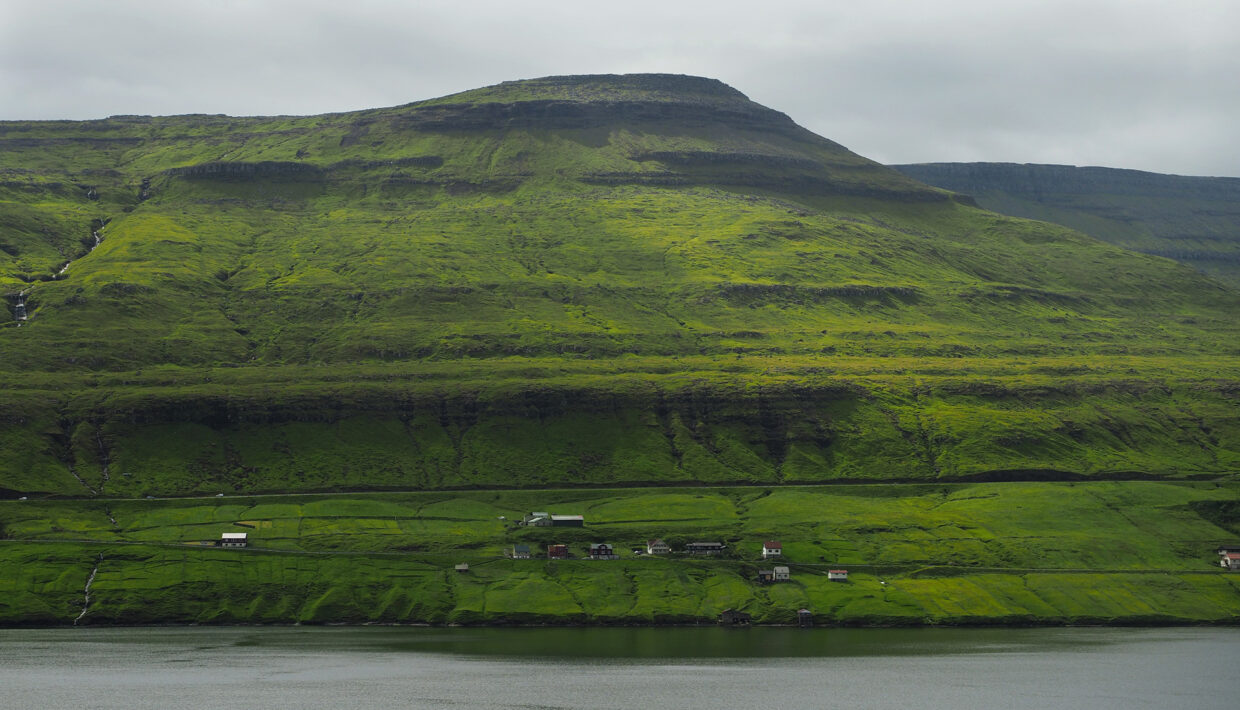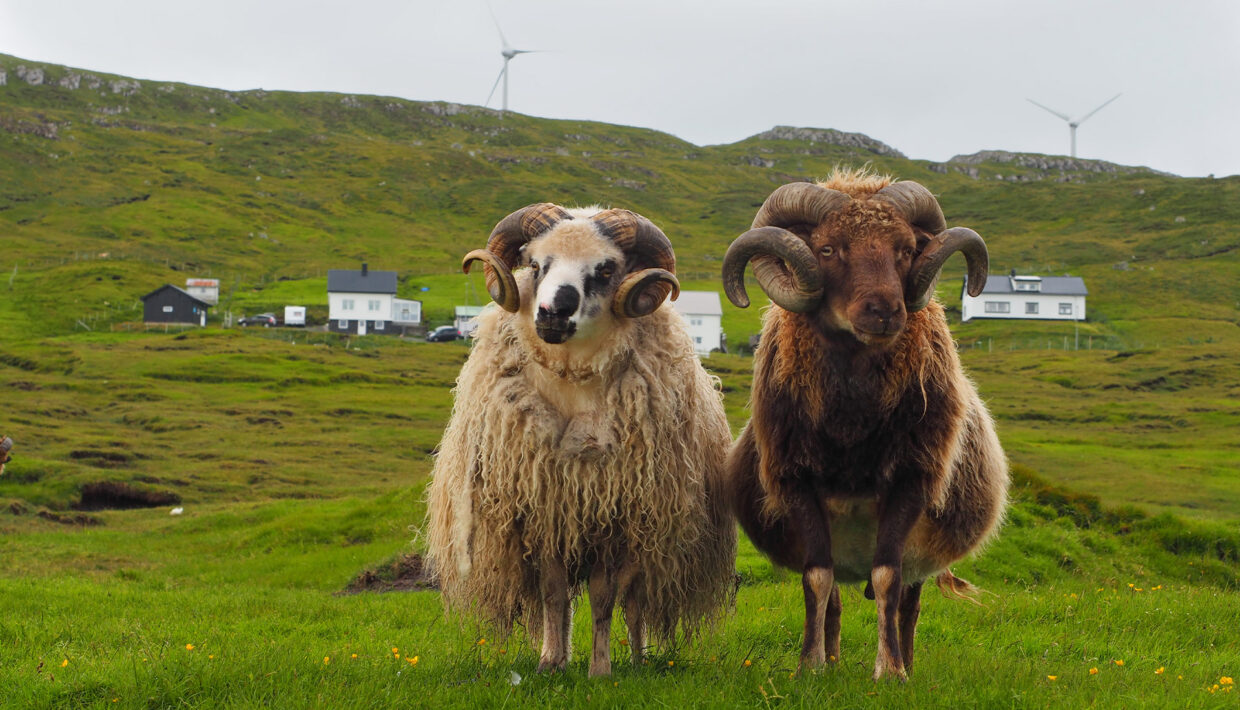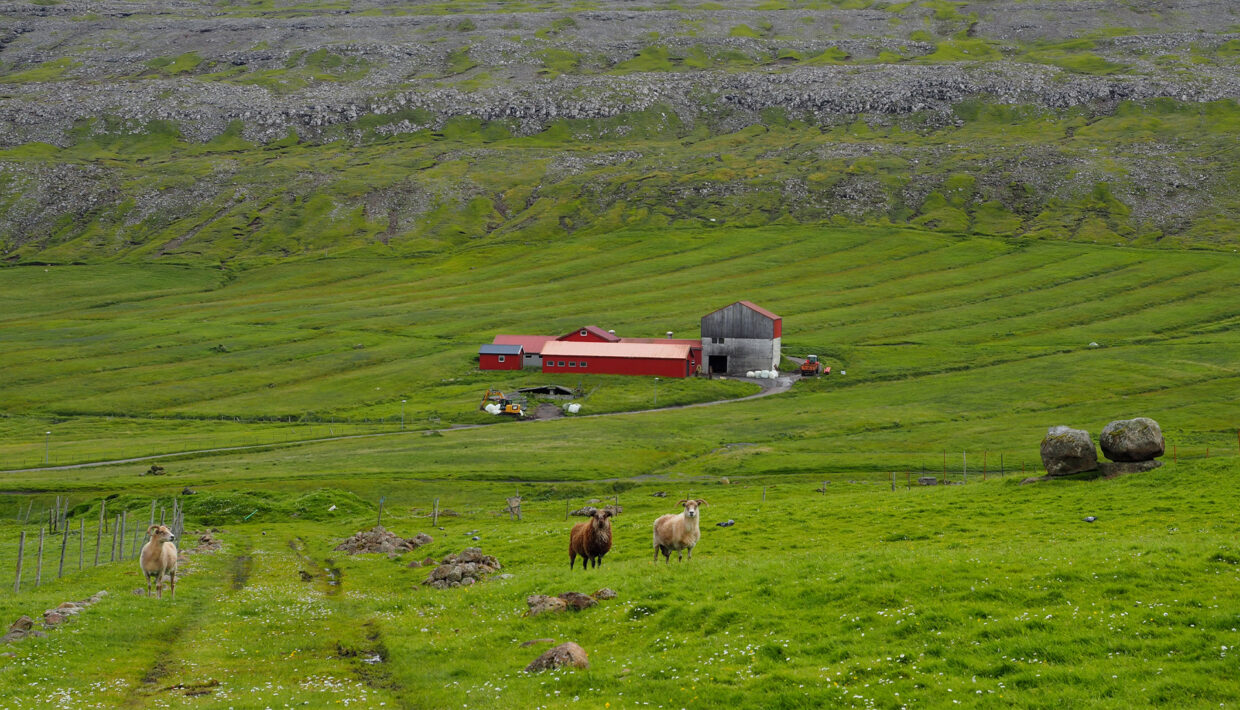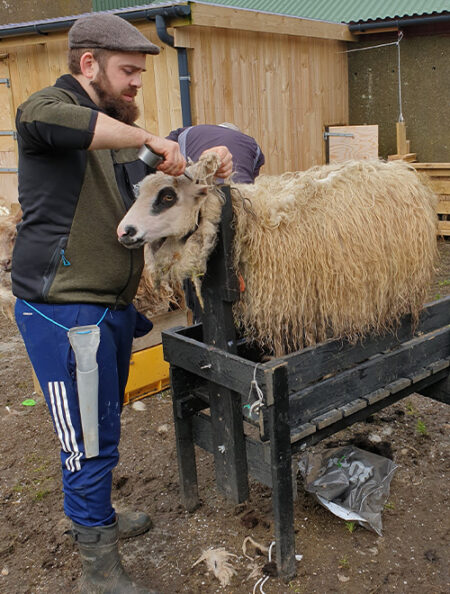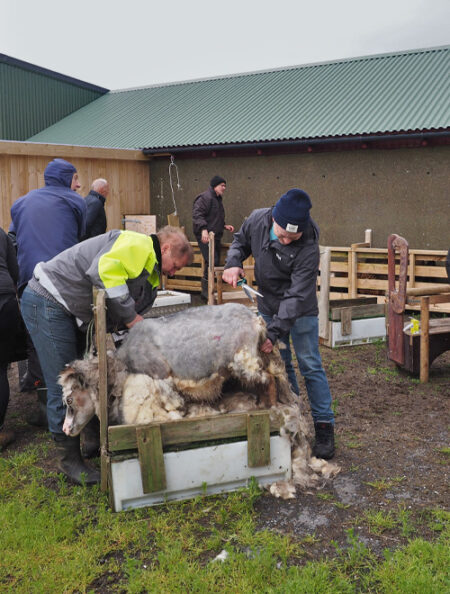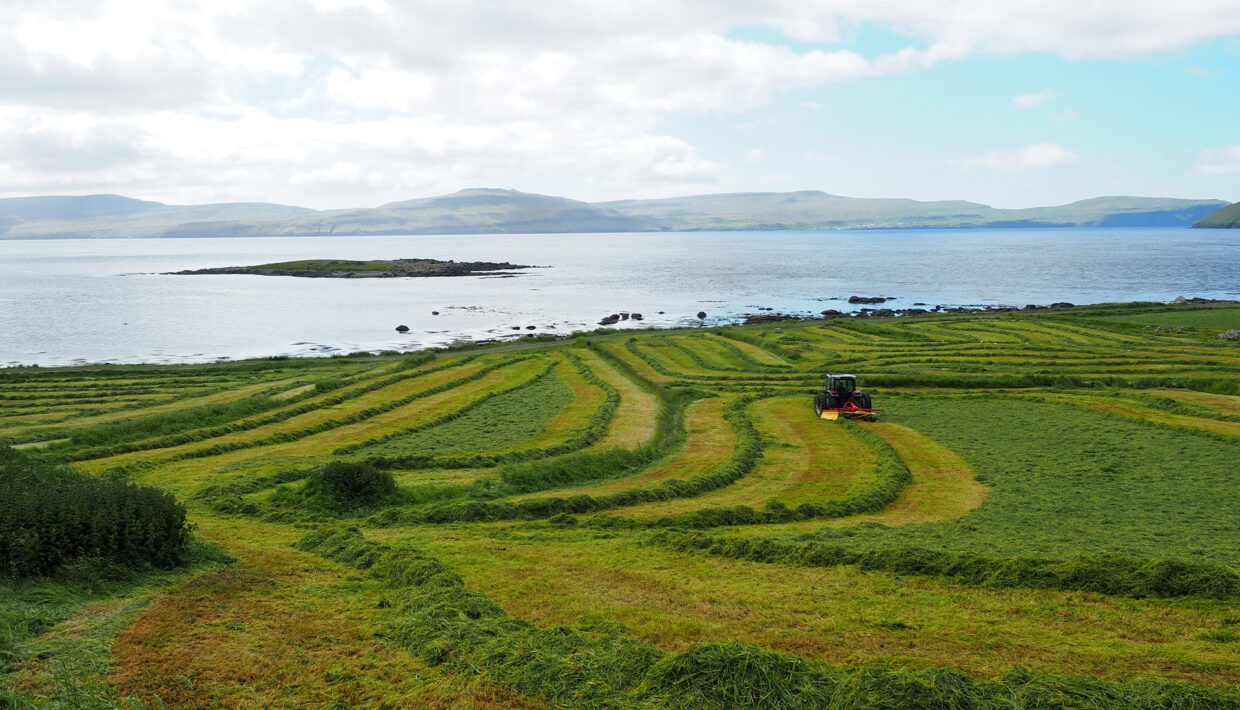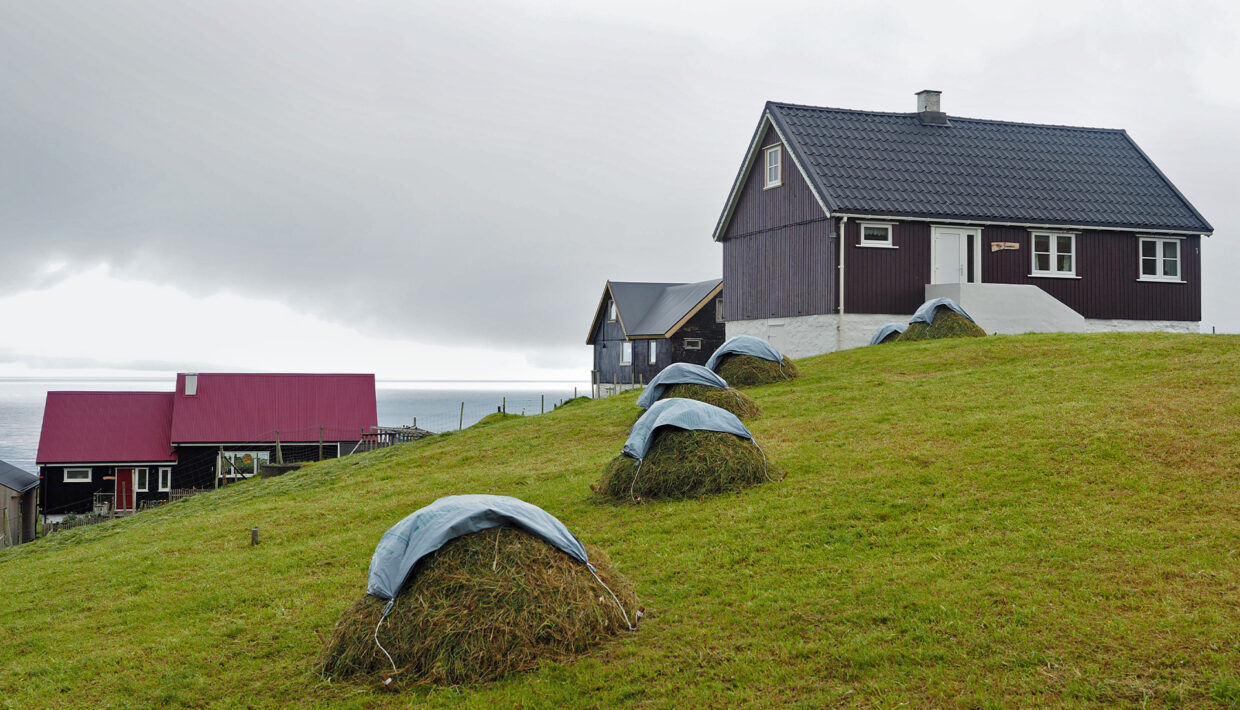The Faroe Islands lie far away from the rest of the world in the North Atlantic, halfway between Norway and Iceland. The 18 islands are largely barren and inhospitable, with cliffs that drop steeply into the sea, battered by the wind and the rain that falls almost 300 days a year. The Vikings reached these islands 1,200 years ago and their descendants partly make up the population of the Faroe Islands today. But why exactly did they settle here in search of a better life? “Legend has it that all the seafarers who felt seasick got off their boats on the Faroe Islands on their way to Iceland, because even today most Faroese are not seaworthy.” Says Harriet Olafsdóttir, before giving us a cheeky wink.
The 33-year-old works as a sheep farmer on the southernmost tip of Eysturoy, the second largest island in the North Atlantic archipelago. Her sheep farm, Hanusarstova, is situated in a beautiful location on the edge of the 28-house village of Æðuvík. The farm is sheltered at the back by mountains, and in front boasts an unobstructed view over sheep pastures to the sea. On the Faroe Islands – or the “Sheep Islands”, as they are called in Danish – there are more sheep than people: the islands’ 54,000 inhabitants are well outnumbered by the more than 80,000 sheep who reside here.
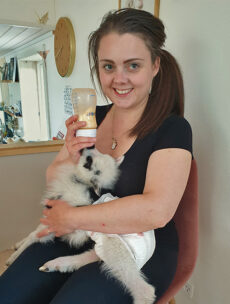
Harriet Olafsdóttir, sheep farmer on the Faroe Islands
Unique breed: The Faroe sheep
The Faroese sheep are an official breed and most likely descend from the Norwegian Spaelsau and Icelandic sheep. In the 19th and 20th centuries, some Scottish Blackface were imported to improve the wool quality; crossbreeds of which still exist today. The Faroe sheep are said to have over 300 different fleece colours and their wool is still used locally in knitwear.
The Faroe sheep live outdoors all year round and are fairly small, sturdy sheep that cope well with the climate and soils on the islands. Harriet’s farm has around 70 ewes with offspring. The pastures where the sheep roam are distributed around the farm, with a mixture of fenced, drained grazing areas heading out towards the sea, as well as open grazing areas stretching up the mountains. Drivers on the Faroe Islands are always advised to drive carefully, because you never quite know where a sheep might attempt to cross the road there.
The pastures are “king’s land”, as Harriet refers to them; state-owned land which she leases for 180 kroner (£20). As part of the agreement, the government stipulates the exact number of sheep she can keep on the land. The ewes only give birth to one lamb on average, but that is more than enough, considering they have to make do with the island’s sparse grasslands.
The lambs are slaughtered when they grow to around 15-20kg liveweight, with home slaughtering being the most common method across the islands. “We rear and slaughter about 55 lambs a year,” Harriet says. Only a third of the lambs are sold; the rest are kept for private consumption by Harriet’s family and friends. “Everyone who has helped us over the year gets their share; for a day’s work you can look forward to getting a whole lamb.”
Sheep farming is a tradition
Sheep meat and sheep-based food products are an important part of the Faroese diet. Although large amounts of food are now imported from Denmark, for centuries nature dictated the menu in these parts, with fish and lamb being the most important staples. A traditional method of preserving meat and fish is “raest”, a method of fermentation typical in the Faroe Islands. Raw meat is air-dried and then left to hang for several months until it begins to decay. The process is a science in itself. Acquiring the right flavour depends on ensuring the perfect climatic conditions; too warm a temperature and the taste is spoilt, too cold and fermentation is prevented, too much wind and the food is rendered tasteless.
On every island, the meat can taste different.
Harriet Olafsdóttir
“On every island, the meat can taste different,” Harriet notes, as she sits with her husband John and their two young daughters at supper. They’re cutting wafer-thin slices of meat from a leg of lamb before sandwiching them between slices of buttered bread. The meat has a deep red colour and tastes particularly tender. “It’s because my animals are exclusively grass-fed that the meat is so good,” the young sheep farmer adds.
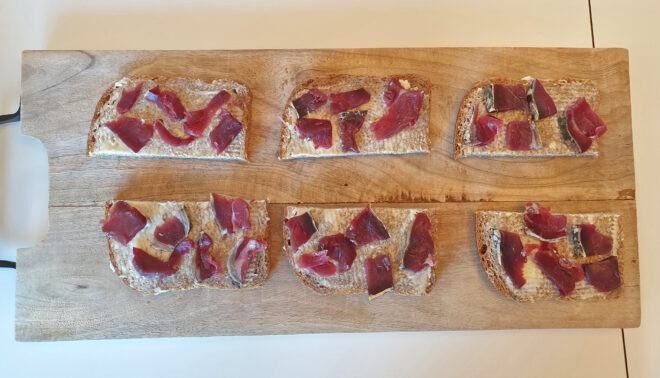
Sheep meat is traditionally fermented on the Faroe Islands. It has a deep red color and is particularly delicate.
A sheep-farming rose among the thorns
Harriet is the only woman in the Faroe Islands to have taken up sheep farming as her sole profession. “There are a lot of men in their sixties in the business,” she laughs. And they are not at all happy about the way she does her job. Although around 900t of sheep meat are produced on the islands every year, very few of the 400 or so sheep farmers can make a living from it. Sheep farming in the Faroe Islands has always been mainly a secondary occupation. For a 15kg lamb, Harriet receives 1200 kroner, which works out at about £9/kg, she says. “Far too little to make a profit.” But despite the small pay slip, she never wanted to do anything but be a sheep farmer.
At the age of four, her grandfather already had her out in the field with the sheep. And for four years now she has been responsible for the flock herself. Initially, her family was unsupportive of her ambition to take over running the farm, as they believed it was no job for a woman. But when none of her four brothers wanted to take on the role, the family gave in, Harriet recalls.
Faroese culture and the humble sheep
Sheep farming in the Faroe Islands is about more than just money. It is a central part of the self-governing territory’s culture, and it is greatly important to the communities there. Sheep owners whose pastures border each other meet regularly during the year to support each other. They help one another with slaughtering as well as driving the sheep down from the mountains when the time comes to vaccinate or shear them.
They alternate whose pastures they meet on. This time it is the turn of Harriet and John’s sheepfold. It’s the end of July and following two long-awaited rain-free days, it’s time to shear the sheep before summer. Sheep shearing is and remains a hands-on job. As always, several old-fashioned wooden trestles are at the ready for the event. It takes two strong men to hoist a sheep onto the trestle and secure its head in the wooden flap. In total, around 15 men have come to help with the shearing and the children are also allowed to pitch in.
Modern ideas for profitable sheep farming
Although she is criticised for taking on the farm, Harriet wants to prove that it is possible to make money with sheep farming. A few years ago, she started photographing her sheep. But she doesn’t just take any old photos. Not at all. She captures impressive close-ups of her sheep adorned with flowers and hand-made head wreaths. “I am only able to do it because my sheep have great trust in me,” she says. The photos subsequently appear on numerous postcards, posters and T-shirts and are sold in many shops in the Faroe Islands as well as online.
I didn’t have to do any publicity at all. People just found me on Instagram.
Harriet Olafsdóttir
“I make as much money with two big posters as I do with one sheep,” the young sheep farmer turn photographer adds. The photographs have become so popular she is now on social media. After having started as a blogger, she has now turned her attention to Instagram, where she has amassed a total of 10,500 followers. “People are interested in what happens on our farm.” This summer, the young family also finished building a holiday house and in no time it was booked up for the rest of the year. “I didn’t have to do any publicity at all. People just found me on Instagram.” German and French television reports on Harriet and her farm meant many fans already knew to find her on social media.

Harriet Olafsdóttir’s farm also has Faroese horses. There are only 90 of this traditional breed left in the Faroe Islands.
A changing dairy industry
Harriet has a soft spot for traditional livestock breeds. Her farm also houses four Faroese horses. Found nowhere else in the world, there are only around 90 left on the islands, she says. She also wanted her own domestic Faroe Island cattle. “I would have been living the dream,” she laughs. But the old cattle breed which was native to the islands has been extinct since 2010. “The state lost interest in them,” Harriet tells. The breed was not suitable for milking machines, produced little milk and did not fit into the program to modernise the islands’ milk production.
Today, the Faroe Islands are able to cater to their own milk and dairy product needs, according to official sources. In the past 10 years alone, household dairy milk production has increased by 10%, while the number of dairy farms has fallen from 28 to 16. The remaining farms house a total of 900 dairy cows and operate as a co-operative, encompassing dairy farming, production, and distribution. They supply 7.5m litres of milk annually, which, in addition to drinking milk, is used to make yogurt, butter and a small amount of cheese.
Dairy farmer Roi Absolonsen, who is based on the island of Viðoy, runs one of the island’s most modern dairy farms with 120 dairy cows in co-operation with two business partners. And that means indoor housing. On the Faroe Islands the winters are mild, with maximum temperatures of 4°C, while the summers are mostly cloudy with highs of 15°C. That said, it can be extremely windy and rain heavily at any time. The soils are wet and the modern dairy breeds that are on the farms today – at Absolonsen, this is mainly Holstein-Friesian cattle – are too heavy to roam them.
To protect the soil, the animals are kept in the barn and only the youngstock go out to pasture from June to September. To simplify the farming process, a milking robot and a TKS robot feeding system, which feeds the cattle up to 10 times a day, are used on the farm. It comprises 60ha of grassland, 5ha of which are rented out. In addition to grass silage, concentrates like soyameal are also fed to the cattle. Because of the poor soil conditions, most of the cattle feed on the Faroe Islands is brought in from abroad – mainly from Norway and South America.
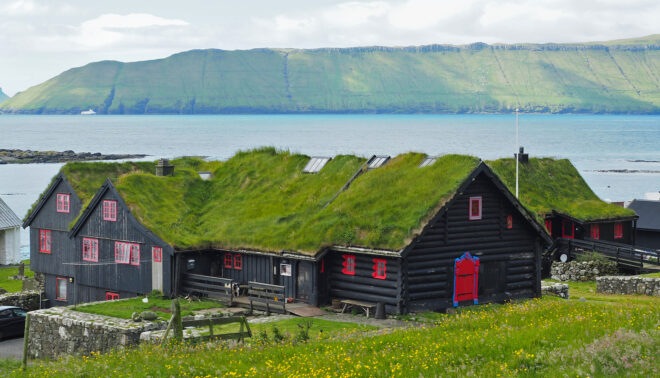
Kirkjubøur is located south of the capital Tórshavn. The tiny village consists of a few black wooden houses with grass roofs.
Producing hay here is a gamble, Harriet acknowledges. She can still remember summers when she never left the farm in fear that the sun could come out at any time. The weather is extremely unpredictable, she explains, adding that it can change from one hour to the next as well as from one island to the next. Last year (2021) was a prime example of this and resulted in a failed hay harvest, she says. This year, she has decided not to take the risk and bought hay for her sheep from Iceland instead.

Óli and Anna Rubeksen, sheep farmers
17 farming generations later and still going strong
But if the sun shines long enough, then the fields come to life. July is nearing its and and 11km south of the Faroese capital, Tórshavn, in Kirkjubøur – a tiny village of black, grass-roofed wooden houses – four tractors are on the move in the meadows. In a jaw-dropping setting, with fields reaching down to a dark-blue shimmering sea surrounded by barren islands rising into the sky behind them, the tractors are hard at work mowing and turning grass. “That must have been Jóannes Patursson’s four sons,” Óli and Anna Rubeksen later tell us when we pay them a visit at their farm. The couple run a sheep farm with 150 ewes just a few kilometres further along the coast in Velbastaður.
The Patursson family have been farmers for 17 generations and are said to be the longest established family farming business in the world. Their farmhouse in Kirkjubøur dates back to 1350 and has become somewhat of a tourist attraction. People can pay 50 kroner (£5.70) to visit the farm, while groups can arrange to have their dinner there. At the Tórshavn Tourist Office, the offer is advertised as “Dining with Farmers”.
At Óli and Anna’s farm, you don’t have to be a part of a group to get a good feed. You can also sign up to go for dinner by yourself. So far, business at their farmhouse kitchen is going swimmingly. When they first opened the kitchen, the Rubeksens only catered for guests once a month, but now find themselves serving up meals twice a week. Tonight, 16 people are seated around their large dinner table, waiting to be treated to some delicious food made from ingredients sourced from the farm. Roast lamb heart, fatty cuts of lamb, potatoes, turnips and rhubarb compote are among the specialities the guests can expect to sample. But feasting at the Rubeksen dinner table comes at a handsome price: A five-course meal will cost you just under 1000 kroner (£113) – the hosts greatly appreciate your patronage.
Facts about the Faroe Islands
- Approx. 53,900 inhabitants, almost half live in the capital Tórshavn
- 18 islands, many are connected by tunnels or bridges
- Only about 2.15% of the land is used for agriculture
- The agricultural sector makes up about 1.5% of the territory’s gross domestic product; its main source of income is fish
- Autonomous area with its own government, belonging to the Kingdom of Denmark, not a member of the EU.
(kvf.fo und other sources)


